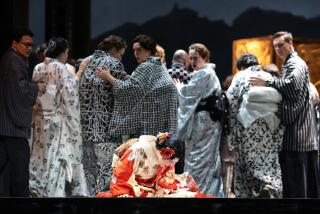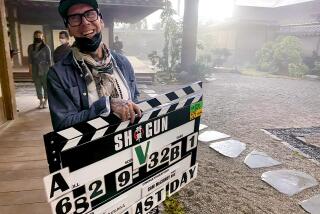This Is No Simple Puppet Show
- Share via
Devious political machinations, violent battle and graphic beheadings--not the usual fare of puppet theater, but then this is puppet theater from Japan. In a country where animation is not for children only, we also find puppet theater designed for adult tastes. The Japanese already boast a long tradition of bunraku, where Kabuki-like mannequins enact complex tales of love and war, loyalty and betrayal. Now the Kageboushi Theatre Company of Tokyo has advanced the art by combining Japanese and Chinese puppetry forms in their adaptation of a Chinese historical epic.
The result, “San Guo Zhi” (or “Tale of Three Kingdoms”), launches a world tour at the Japan America Theatre in Little Tokyo next weekend, a two-hour tour de force of small-scale theater.
“This production was created not only for teenagers, but adults as its audience,” says Yasuaki Yamasaki, president of Kageboushi and executive producer of “San Guo Zhi.” “This story includes universal themes about the essence of human beings.”
Nearly operatic in its attention to detail, the project started 1988, when Kageboushi decided to commemorate the tenth anniversary of the Sino-Japanese Peace and Friendship Pact by working in collaboration with a Chinese counterpart. It found a willing partner in the Yangzhou Puppet Troupe and sent a team to study and work with it. (Three years ago it switched to the Chengdu Puppet Arts Theatre Company, its current partner.) Separately, Kageboushi commissioned a script by James Miki, a well-known television scriptwriter, and dolls by celebrated craftsman Kihachiro Kawamoto.
In Japan “San Guo Zhi” (or “Sangokushi” in Japanese) has already attracted an audience of 1.2 million over the past decade. The current tour is the first foray of the show outside Japan, and stops will include Dallas, New Orleans and New York, as well as destinations in several other countries.
The tale, familiar to schoolchildren in China and Japan, is taught in schools and reiterated in popular comic books. This production portrays only two episodes from the saga, which takes place in 3rd century China at the fall of the Han Dynasty. In Part 1, “Three Visits of Supplication,” loyalist general Liu Bei Xuande goes to Sleeping Dragon Hill to plead for the support of brilliant military strategist Zhuge Liang Kongming. It takes three visits to get Kongming’s attention, but Kongming helps work out a strategy to divide China into three kingdoms.
Part 2, “The Battle of the Red Cliff,” presents a turning point in the war between Liu Bei and his enemy Cao Cao--and depicts all the devious strategies necessary to gain the upper hand.
The complexity of the story may make all this difficult for young children to follow, let alone for adults who did not grow up with it. English translation of the text will be projected to the side of the proscenium, and the production is replete with plenty of scene changes and special effects--waves created by billowing cloth, men galloping on horseback and burning ships.
*
The puppets themselves are also intriguing. Standing about 4 feet high, they combine Japanese and Chinese construction techniques. Their heads are made in a method shared by both countries--paper glued over a clay or gypsum base, then painted. Extraordinary attention was paid to the costuming. The style of dress is ancient Chinese, but some 1.5 tons of old kimonos and sashes were shipped from Japan to China to construct the outfits. “My puppets always require antique fabric,” explains Kihachiro Kawamoto, 74, one of Japan’s most celebrated doll makers and the wizard behind the actors of “San Guo Zhi.”
For him, once a puppet is made, it has a life of its own, and the proficient puppeteer has a duty to discover it. “It is necessary for the puppet artists to train themselves until they can hear the voice of the puppets,” he says. “Then they will realize what the puppets really want.”
In fact, these dolls have a prodigious range of movement due to ingenious construction. The eyes, brows and mouths move, although emotions and moods must be conveyed primarily through gesture--the lowered head, the torso prostrate with grief. With one hand the puppeteer controls the doll’s head and holds up its torso; with the other hand he holds sticks that control the puppet’s hands and arms. To execute more elaborate movements, such as the taking of a letter from a messenger, a second puppeteer is needed.
A compromise between Japanese and Chinese cultures was reached for the puppeteers--in bunraku, manipulators are in full view, though cloaked in black so audiences can pretend not to see them. In the Chengdu tradition, puppeteers are hidden beneath a panel. In the Kageboushi production, the panel is lowered, revealing the upper torso and head of the puppeteers, who dress in black, with hoods, in order to be easily ignored.
*
When director Mimi Komori visited China about a decade ago to prepare for the production, she noted many differences in how the puppets were used and how performances were created. “First they practice without the dolls--as if they were the actors and actresses themselves,” she recalls, “so they read the dialogue and act as if in a regular theater.” Later they practice with the puppets, transferring their own gestures and movements to their surrogates. In one area the transfer remains direct--since the puppeteers hold up the puppets, they create the stride of their wards through their own stride.
Komori acknowledges that Kawamoto “created the actors,” but she also had to find the right puppeteer to bring them to life. “I did ask the Chinese company for advice on who would be good for each role,” she says. “In China each puppeteer tends to have his or her own specialty. Even among women, some are good with dancing, some are good with martial arts movements.”
She also respected the Chinese gestural tradition, much of it derived from the Peking Opera stage, arguably China’s greatest form of theater. For example, generals and statesmen “walk” in a broad, slightly rolling gait, and characters tend to punctuate statements with a flourish of their long sleeves. Komori was more focused on redirecting nuance, not form.
“I wanted to concentrate on the psychology of the characters--Sangokushi is mostly about human interactions, a war of minds,” she says. “In order to depict that, I wanted the puppeteers to express the inner psychology of the characters.” At first the Chinese found this a bit hard to get used to, but then, she observes, “They got to really enjoy doing this because it was different.”
From the beginning, the concept was to have Chinese and Japanese puppeteers working side by side, and the current team is made up of eight Chinese and four Japanese puppeteers. Since the dialogue is in Japanese, a special technique had to be devised for rehearsals. At first the prerecorded dialogue was played in Chinese on one speaker, Japanese on the other, with the Chinese somewhat louder. Over time, the balance was reversed, until finally only the Japanese dialogue remained.
While the producer and the advance publicity emphasize the high moral purposes of the story, this is a history seen from the point of view of the winners--Chinese history in the “official version,” much embellished to suit those who eventually sat on the throne. In essence, the history has the flavor of fables, and even director Komori admits that the story is “old-fashioned” and the characters archetypal, but she believes that puppets are suited for certain kinds of theater, like this one.
“Puppets have no doubts, they never have a hangover,” she says.
The production has been an extraordinary collaboration. “So many people put so many resources into this production, in terms of finances and time and everything,” Komori says. “It could be the first and the last time anything quite this extravagant will ever be done.”
*
“SAN GUO ZHI,” Japan America Theatre, 244 S. San Pedro St., Little Tokyo. Dates: Saturday at 8 p.m., Sunday at 2 p.m. Prices: $18 to $20. Phone: (213) 680-3700.
More to Read
The biggest entertainment stories
Get our big stories about Hollywood, film, television, music, arts, culture and more right in your inbox as soon as they publish.
You may occasionally receive promotional content from the Los Angeles Times.










